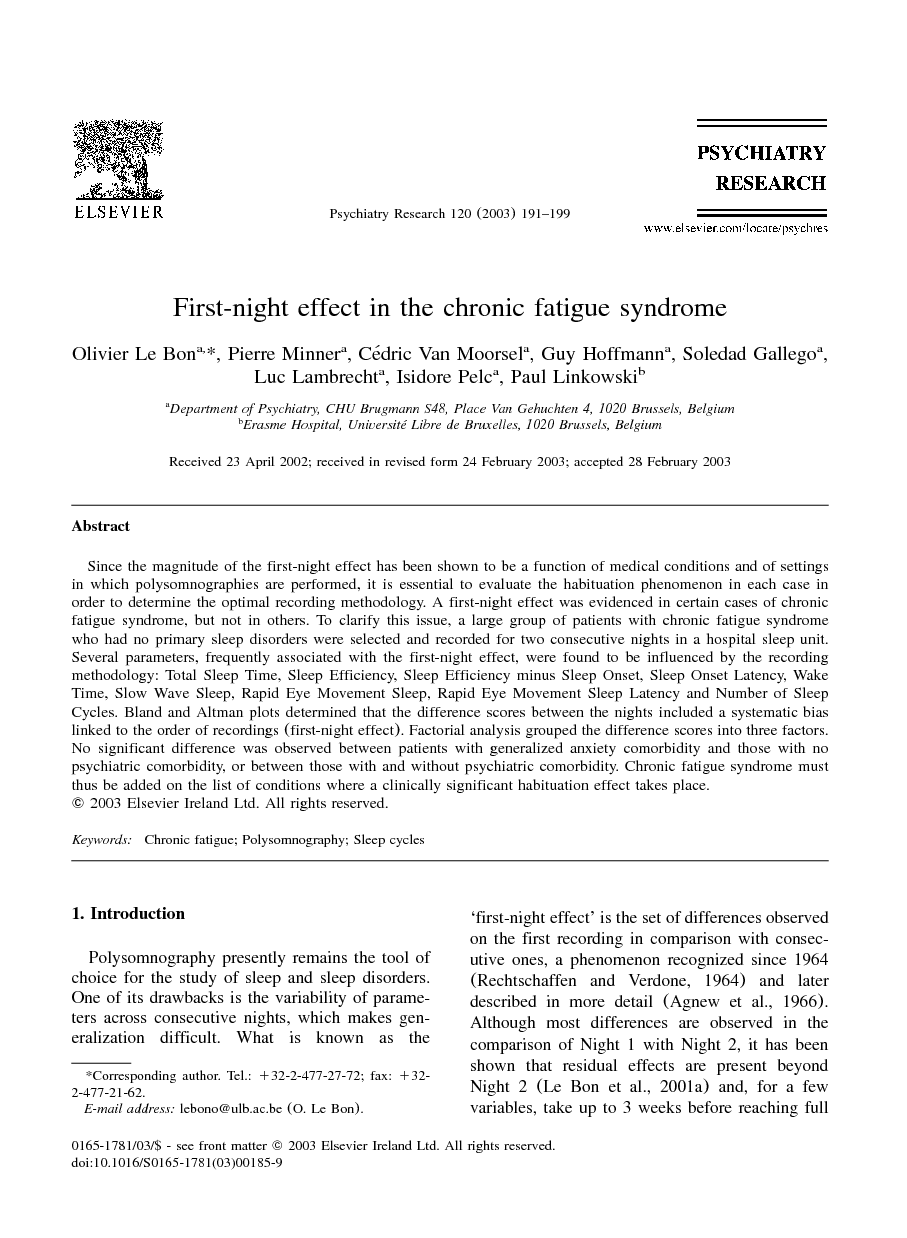Since the magnitude of the first-night effect has been shown to be a function of medical conditions and of settings in which polysomnographies are performed, it is essential to evaluate the habituation phenomenon in each case in order to determine the optimal recording methodology. A first-night effect was evidenced in certain cases of chronic fatigue syndrome, but not in others. To clarify this issue, a large group of patients with chronic fatigue syndrome who had no primary sleep disorders were selected and recorded for two consecutive nights in a hospital sleep unit. Several parameters, frequently associated with the first-night effect, were found to be influenced by the recording methodology: Total Sleep Time, Sleep Efficiency, Sleep Efficiency minus Sleep Onset, Sleep Onset Latency, Wake Time, Slow Wave Sleep, Rapid Eye Movement Sleep, Rapid Eye Movement Sleep Latency and Number of Sleep Cycles. Bland and Altman plots determined that the difference scores between the nights included a systematic bias linked to the order of recordings (first-night effect). Factorial analysis grouped the difference scores into three factors. No significant difference was observed between patients with generalized anxiety comorbidity and those with no psychiatric comorbidity, or between those with and without psychiatric comorbidity. Chronic fatigue syndrome must thus be added on the list of conditions where a clinically significant habituation effect takes place.
Polysomnography presently remains the tool of choice for the study of sleep and sleep disorders. One of its drawbacks is the variability of parameters across consecutive nights, which makes generalization difficult. What is known as the ‘first-night effect’ is the set of differences observed on the first recording in comparison with consecutive ones, a phenomenon recognized since 1964 (Rechtschaffen and Verdone, 1964) and later described in more detail (Agnew et al., 1966). Although most differences are observed in the comparison of Night 1 with Night 2, it has been shown that residual effects are present beyond Night 2 (Le Bon et al., 2001a) and, for a few variables, take up to 3 weeks before reaching full steady-state (Wohlgemuth et al., 1999)—so that the phenomenon should in fact more appropriately be called a ‘polysomnography habituation effect.’
The main characteristics of the first night effect include the following: less Total Sleep Time (TST) and Rapid Eye Movement (REM) sleep, Lower Sleep Efficiency index (SEI), more intermittent Wake Time (Wake Time), and longer REM Latency (RL), whereas no clear patterns have been described for non-REM (NREM) sleep.
The origins of the first-night effect are probably multifactorial and may include the following: (1) discomfort caused by electrodes; (2) limitation of movements by gauges and cables; and (3) potential psychological consequences of being under scrutiny. Factors that can influence the magnitude of the habituation process are: (1) Setting in which recordings are performed. In most cases, studies have been performed in specialized sleep units, adding a change in environment to the list of potential causes for first night effect. It has been proposed that home recordings, or a higher level of comfort in sleep units, could reduce or suppress the first night effect, to the point that first nights could be used without habituation ( Coble et al., 1974 and Browman and Cartwright, 1980). However, a home study in healthy controls has shown habituation effects of a magnitude comparable to what is usually observed in hospital sleep units ( Le Bon et al., 2001a). (2) Medical condition. The first night effect was shown to be an important issue in sleep apneic disorders ( Le Bon et al., 2000a) but was found less important in inpatients with depression ( Toussaint et al., 1995), insomnia ( Edinger et al., 1997 and Edinger et al., 2001) and posttraumatic stress disorder ( Saletu et al., 1996). It is even considered of little clinical significance in the use of plethysmography for the detection of male impotence ( Kader and Griffin, 1983). (3) Patient age. Older age has been linked to a more severe first night effect ( Webb and Campbell, 1979).
Because medical conditions can affect the magnitude of the first night effect, the presence and clinical importance of habituation effects have to be examined in each case, in order to determine the optimal recording strategy. Relevant to chronic fatigue syndrome, one study on fibrositis, a related syndrome, reported a first night effect limited to an increased RL and an increased number of awakenings per hour (Gupta and Moldofski, 1986). Another study on fibrositis reported only an increased RL (Whelton et al., 1992). The polysomnographic studies in chronic fatigue syndrome either used a habituation night as a precaution (Greenberg et al., 1995, Fischler et al., 1997 and Morehouse et al., 1998) or considered that, on theoretical grounds, no first night effect would be present and recorded only one night (Stores et al., 1997 and Sharpley et al., 1997).
The present study analyzes two consecutive recordings in a large group of patients with chronic fatigue syndrome in a sleep unit setting, the null hypothesis being that no habituation effect would be present.


